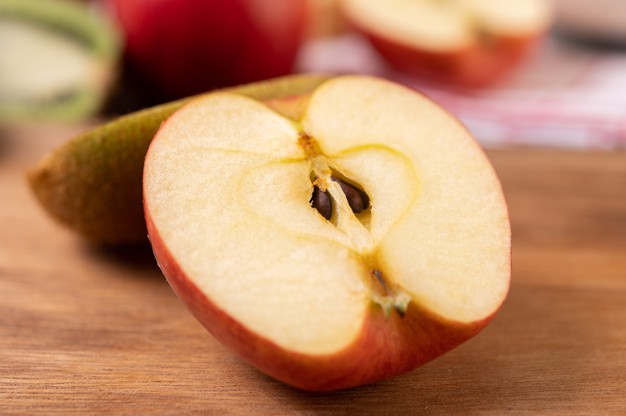Apple fruit contains fiber, water, sugar, vitamin C and some other nutrients. Apples also contain numerous Enzymes that cause in apple oxidation into turning brown when we slice or peel the apple fruit. These Enzymes which are present in chloroplast cells are Tyrosinase and phenolic oxidase Enzymes. When the peeled or sliced apple is exposed to air, the Enzymes react with Oxygen and phenolic compounds convert to o-quinones. So, the phenolic oxidases Enzymes are the reason of apples turning brown.

Other than oxidation caused by Enzymes, some other factors also results in apple slices browning. Some apple varieties turn brown quicker than other apple types. For example, Red Delicious apple type turns brown quicker than Golden Delicious apple type. In comparison to Red Delicious and Golden Delicious, Granny Smith survives better and turns brown slower than the other two apple types. Moreover, the maturity amount and the growth conditions of the apple fruit are influential in the browning process of the apple fruit. When the apple fruit is ripe, it turns brown quicker than when it’s unripe.
When the apple fruit color turns brown, it results in loosing vitamin C. when we preserve the apple fruit to be used in a raw manner, we should use some chemicals to control the enzymes and prevent the apples from turning brown.
The chemical that is used for this purpose is ascorbic acid or vitamin C. ascorbic acid can be found pure or mixed with other commercial compounds.
For short periods, citric acid, lemon juice or sugar syrup help preventing apple fruits from turning brown. But, these solutions are not as effective as pure ascorbic acid.
Lemon juice is a mild acid which decelerates the oxidation reactions and consequently decreases the coloration process. The positive point about lemon juice is that it is completely natural and there would be no need to use other commercial chemicals. Likewise, you can apply ginger ale and pineapple juice as a natural addition for preventing coloration.
The other solutions that can be applied are saline water and sugary water. But, salt or sugar may cause in some health problems.
The other easiest way to immerse apple fruit slices in water, but it works just for some hours. Immersing apple fruit in water prevents the contact between apple fruit flesh and air. Consequently, the phenolic compounds won’t get oxidized and the apple fruit slices do not turn brown. Also, wrapping apple fruit halves in plastic or heating in hot water help preventing coloration of the apple fruit slices.
